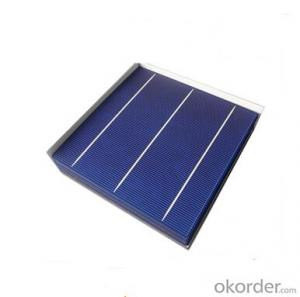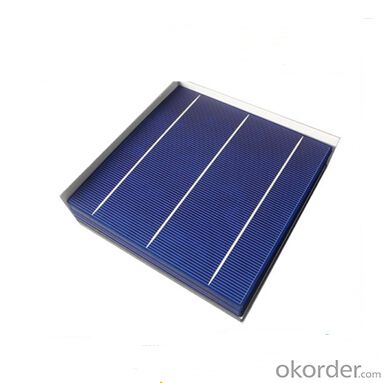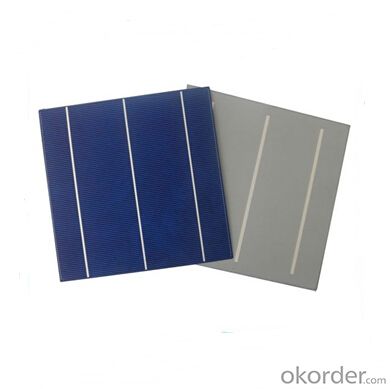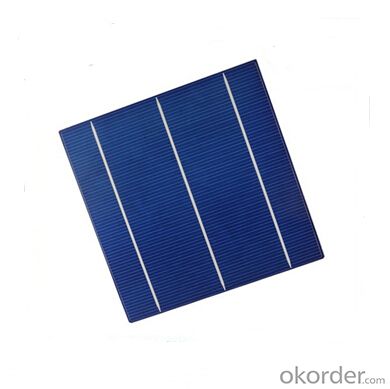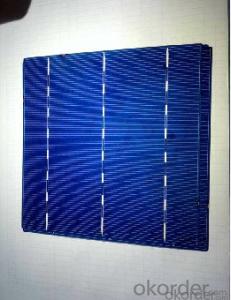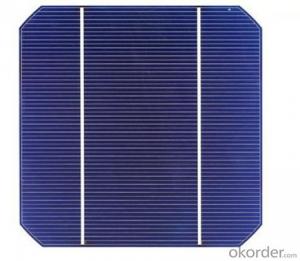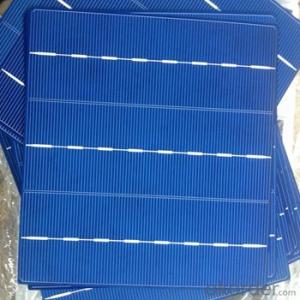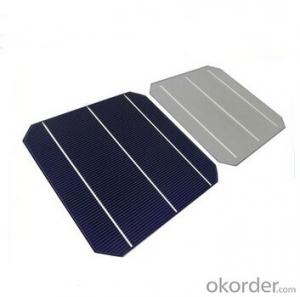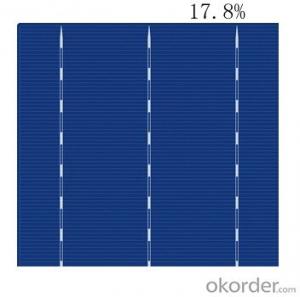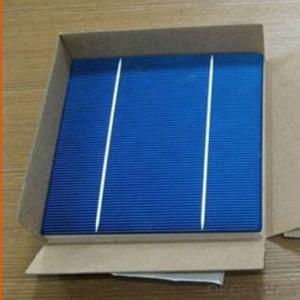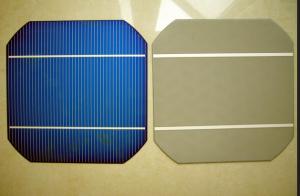Aerospace Grade Polycrystalline Solar Cells - High Efficiency, Low Price
- Loading Port:
- Shanghai
- Payment Terms:
- TT or LC
- Min Order Qty:
- 5000 pc
- Supply Capability:
- 8000000 pc/month
OKorder Service Pledge
OKorder Financial Service
You Might Also Like
Brief Introduction of Solar Cells
A solar cell, is an electrical device that converts the energy of light directly into electricity by the photovoltaic effect, which is a physical and chemical phenomenon. It is a form of photoelectric cell, defined as a device whose electrical characteristics, such as current, voltage, or resistance, vary when exposed to light. Solar cells are the building blocks of photovoltaic modules, otherwise known as solar panels.
Polycrystalline Silicon Solar Cells Advantage:
• High efficiency and stable performance in photovoltaic conversion.
• Advanced diffusion technique ensuring the homogeneity of energy conversion efficiency of the cell.
• Advanced PECVD film forming, providing a dark blue silicon nitride anti-reflection film of homogenous color and attractive appearance.
• High quality metal paste for back surface and electrode, ensuring good conductivity, high pulling strength and ease of soldering.
• High precision patterning using screen printing, ensuring accurate busbar location for ease with automatic soldering a laser cutting.
Usage of Polycrystalline Solar Cells
Solar cells are often electrically connected and encapsulated as a module. Photovoltaic modules often have a sheet of glass on the front (sun up) side, allowing light to pass while protecting the semiconductor wafers from abrasion and impact due to wind-driven debris, rain, hail, etc. Solar cells are also usually connected in series in modules, creating an additive voltage. Connecting cells in parallel will yield a higher current; our solar cells have passed IEC Certification. With high and stable quality, our cells can greatly improve the performance of Solar Modules.
Specification:
Mechanical data and design |
Format - 156 mm × 156 mm ± 0.5 mm |
Thickness- - 200 μm ± 20 μm |
Front (-) - 1.4 mm bus bars (silver),blue anti-reflection coating (silicon nitride) |
Back (+) - 2 mm wide soldering pads (silver) back surface field (aluminium) |
Temperature Coefficient of Cells |
Voc. Temp .coef.%/K -0.364%/K |
Isc . Temp .coef.%/K +0.077%/K |
Pm. Temp. coef.%/K -0.368%/K |
Polycrystalline 156x156mm 3BB | ||||||
EFF Code | EFF. (%) | Pmax(W) | Impp(A) | Vmpp(V) | Isc(A) | Voc(V) |
1760 | 17.60 | 4.28 | 8.060 | 0.531 | 8.610 | 0.633 |
1740 | 17.40 | 4.23 | 8.030 | 0.524 | 8.570 | 0.632 |
1720 | 17.20 | 4.19 | 8.000 | 0.522 | 8.510 | 0.631 |
1700 | 17.00 | 4.14 | 7.850 | 0.521 | 8.490 | 0.622 |
1680 | 16.80 | 4.09 | 7.770 | 0.521 | 8.390 | 0.620 |
1660 | 16.60 | 4.04 | 7.650 | 0.519 | 8.350 | 0.615 |
1640 | 16.40 | 3.99 | 7.580 | 0.516 | 8.290 | 0.615 |
Intensity Dependence |
Intensity [W/m2] Isc× [mA] Voc× [mV] Pmpp |
1000 1.00 1.000 1.00 |
900 0.90 1.000 0.90 |
800 0.80 0.99 0.80 |
500 0.50 0.96 0.49 |
300 0.30 0.93 0.29 |
200 0.20 0.92 0.19 |
IV Curve

Solar Panel Images:

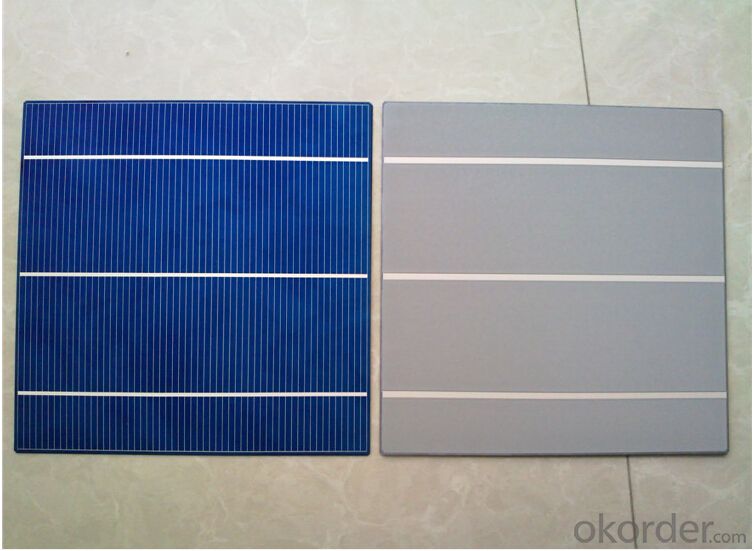
Packaging & Delivery of Polycrystalline Solar Cells
Carton Box Package and Deliver by air. It should be noticed that it should be avoid of water, sunshine and moist.
Faq
We have organized several common questions for our clients,may help you sincerely:
1. What’s price per watt?
A: It’s depends on the quantity, delivery date and payment terms of the order. We can talk further about the detail price issue. Our products is high quality with lower price level.
2. Can you tell me the parameter of your solar cells?
We have different series of cells with different power output, both from c-si to a-si. Please take our specification sheet for your reference.
3. How do you pack your products?
We have rich experience on how to pack the panels to make sure the safety on shipment when it arrives at the destination.
4. Can you do OEM for us?
Yes, we can.
5. How long can we receive the product after purchase?
In the purchase of product within three working days, We will arrange the factory delivery as soon as possible. The perfect time of receiving is related to the state and position of customers. Commonly 7 to 10 working days can be served.
Silicon is the ideal material for solar cells, which is the silicon-based solar cells the main reason. But with the development of new materials and related technologies continue to develop, with other material-based solar cells are also showing more and more attractive prospect.
N-type Crystalline Solar Cell
In the bottom plate of the N-type semiconductor solar cell, a greater resistance to impurities, easier to improve the energy conversion efficiency, in theory, the attenuation rate is relatively low, but the process is more complex and costly. Pentavalent element incorporated in pure silicon crystal (such as phosphorus, arsenic, antimony, etc.), so as to replace the position of the crystal lattice of silicon atoms to form a N-type semiconductor.
At present, has reached large-scale production of N-type silicon solar cells, there are three, namely, Japan's Matsushita N-SiHITN type silicon solar cells, the United States SunpowerIBC structure N-type silicon solar cells, as well as Yingli Panda N-type silicon cells. In market share, the International Technology Roadmap for PV (ITRPV) Expected N-type Crystalline Solar Cell from 2014 up to 18% in 2020 to 50% left and right.
N-type Crystalline Solar Cell industry level: 21% -24%
P- type Crystalline Solar Cell
In the bottom of the P-type semiconductor solar cells, low cost, high attenuation rate, 25 years after the decay rate can reach 15-20%. Incorporation of trivalent elements (such as boron) in pure silicon crystal, so that the position of substitution of silicon atoms in the lattice to form P-type semiconductor.
Industrialization Level - Domestic: 18.7% -19.2% overseas: 19.2% -20%
Battery Polycrystalline
Polycrystalline silicon solar cells combines the high conversion efficiency monocrystalline silicon cells and preparation of amorphous silicon thin film materials as well as long-life battery, etc. relatively simplified new generation of batteries, the conversion efficiency is generally about 12%, slightly lower than the silicon solar cells, there is no obvious efficiency recession, and may be prepared on an inexpensive substrate material, the cost is much lower than silicon cells, and more efficient than amorphous silicon thin film batteries.
Industry level: 17% -17.5%
- Q: Can solar cells be used to power water purification systems?
- Yes, solar cells can be used to power water purification systems. Solar-powered water purification systems use the energy from the sun to generate electricity, which is then used to power pumps, filters, and other components of the water purification process. This sustainable and renewable energy source makes solar cells an effective and environmentally friendly solution for powering water purification systems, especially in areas with limited access to electricity grids.
- Q: How do solar cells perform in areas with frequent tornadoes?
- Solar cells can still function effectively in areas with frequent tornadoes as long as they are properly installed and secured. While tornadoes can cause significant damage to infrastructure, including solar panels, advanced mounting systems and sturdy installations can help mitigate the risks. Additionally, solar cells are designed to withstand various weather conditions, including high winds. However, if a tornado directly hits a solar installation, it may cause damage that would require repairs or replacements.
- Q: Where and how can I find more information of Photovoltaic Cells Solar Panels? Can anybody share more about that?
- Photovoltaic Cells is the electricity from sunlight, you can find a lot more than what I listed for you here from the website such as www.dasolar
- Q: Can solar cells be used in electric fences?
- Yes, solar cells can be used in electric fences. Solar cells can convert sunlight into electricity, which can power the electric fence energizer. This eliminates the need for a constant power supply or batteries, making it a sustainable and cost-effective option for powering electric fences.
- Q: What is Solar Cell Technology?
- It changes our life.
- Q: Can solar cells be used to power farms or agricultural operations?
- Yes, solar cells can be used to power farms or agricultural operations. Solar panels can be installed on rooftops, fields, or other suitable areas to convert sunlight into electricity. This renewable energy source can provide a consistent and sustainable power supply for various farming activities, such as irrigation systems, machinery, and storage facilities. Additionally, solar power helps reduce reliance on fossil fuels, lowers operational costs, and contributes to a greener and more environmentally friendly agricultural sector.
- Q: What is the role of solar cells in powering electric fences?
- Solar cells play a crucial role in powering electric fences by converting sunlight into electrical energy. These cells, also known as solar panels, capture sunlight and generate a direct current (DC) that is stored in a battery. The stored energy is then used to power the electric fence, providing a constant source of electricity without the need for grid connection or fossil fuels.
- Q: Can solar cells be used in disaster response vehicles?
- Yes, solar cells can be used in disaster response vehicles. They can provide a reliable and renewable source of power to charge essential equipment and devices, such as communication systems, lights, and medical equipment. Solar cells are especially useful in remote or off-grid areas where traditional power sources may be disrupted or unavailable during a disaster.
- Q: Can solar cells be used in agricultural settings?
- Yes, solar cells can be used in agricultural settings. They can be installed in farms and greenhouses to generate clean and renewable energy for various agricultural operations such as irrigation, lighting, and powering machinery. Solar cells are a sustainable and cost-effective solution that can help reduce reliance on non-renewable energy sources in agricultural practices.
- Q: Can solar cells be used in hot climates?
- Yes, solar cells can be used in hot climates. In fact, solar panels often perform better in hotter temperatures as they can convert more sunlight into electricity. However, it is essential to consider the heat management of the solar panels to ensure their efficiency and longevity in extreme heat conditions.
Send your message to us
Aerospace Grade Polycrystalline Solar Cells - High Efficiency, Low Price
- Loading Port:
- Shanghai
- Payment Terms:
- TT or LC
- Min Order Qty:
- 5000 pc
- Supply Capability:
- 8000000 pc/month
OKorder Service Pledge
OKorder Financial Service
Similar products
Hot products
Hot Searches
Related keywords
